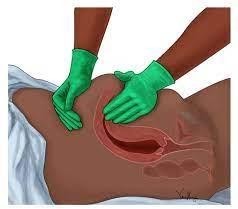A nurse is preparing to administer the hepatitis B vaccine to a newborn. Which of the following actions should the nurse take?
Use a 20-gauge needle to administer the vaccine.
Choose a 3/8-inch needle to administer the vaccine.
Administer the vaccine into the dorsal gluteal muscle.
Administer 0.5 mL of the vaccine.
The Correct Answer is B
A) Incorrect- A 20-gauge needle is too large and could cause unnecessary pain for the newborn.
B) Correct - Choosing a 3/8-inch needle is appropriate for administering vaccines to newborns. he hepatitis B vaccine is given intramuscularly in the anterolateral thigh of newborns. The needle size should be appropriate for the muscle mass and age of the infant. A 3/8-inch needle is recommended for newborns, while a 20-gauge needle is too large and may cause tissue damage.
C) Incorrect- Administering the vaccine into the dorsal gluteal muscle is not recommended because of the risk of injury to the sciatic nerve; the recommended site is the vastus lateralis muscle in the anterolateral thigh.
D) Incorrect- The hepatitis B vaccine is usually administered in a dose of 0.5 mL for newborns, but this is not the only action that the nurse should take.
Nursing Test Bank
Naxlex Comprehensive Predictor Exams
Related Questions
Correct Answer is D
Explanation
Rationale:
A) Incorrect - Applying oxygen is not the priority action in the case of excessive vaginal bleeding and a boggy uterus. Oxygen therapy would be appropriate if there were signs of respiratory distress or decreased oxygen saturation, but it does not directly address the primary concern of uterine atony and bleeding.
B) Incorrect - Administering methylergonovine might be appropriate, but the priority is to address the uterine atony with fundal massage first. Fundal massage helps stimulate uterine contractions and control bleeding, which is crucial in this scenario.
C) Incorrect - Encouraging the client to empty her bladder is important, but it is not the first action to take in the case of excessive bleeding and uterine atony. Immediate intervention to control the bleeding takes precedence.
D) Correct - Initiating fundal massage is the priority action in this situation. A boggy uterus with excessive vaginal bleeding indicates uterine atony, which is a potentially life-threatening condition requiring immediate intervention to prevent further bleeding.
Fundal massage helps the uterus contract and control bleeding. Addressing uterine atony is critical to prevent further hemorrhage and stabilize the client's condition.

Correct Answer is C
Explanation
A) Incorrect- While notifying the provider might be necessary, addressing bladder distention takes precedence in this scenario.
B) Incorrect- Administering an analgesic might be indicated for pain relief, but addressing bladder distention is the priority.
C) Correct - Assisting the client to empty her bladder is the first action to take. A full bladder can prevent the uterus from contracting properly and can lead to excessive bleeding.
D) Incorrect- Monitoring perineal pads for clots is important but not the first action to take when bladder distention is present.
Whether you are a student looking to ace your exams or a practicing nurse seeking to enhance your expertise , our nursing education contents will empower you with the confidence and competence to make a difference in the lives of patients and become a respected leader in the healthcare field.
Visit Naxlex, invest in your future and unlock endless possibilities with our unparalleled nursing education contents today
Report Wrong Answer on the Current Question
Do you disagree with the answer? If yes, what is your expected answer? Explain.
Kindly be descriptive with the issue you are facing.
